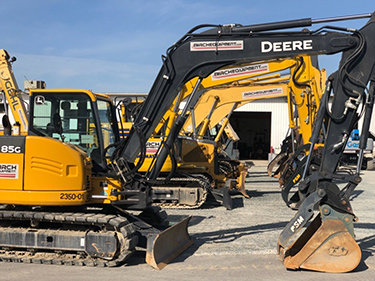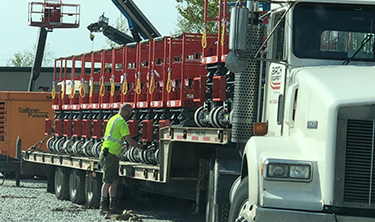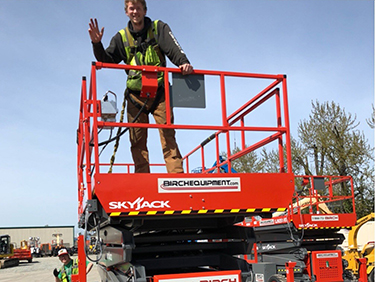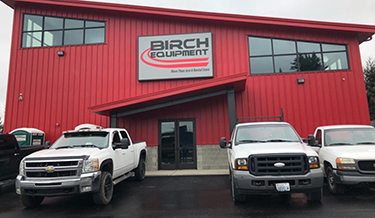|
Subscribe / Renew |
|
|
Contact Us |
|
| ► Subscribe to our Free Weekly Newsletter | |
| home | Welcome, sign in or click here to subscribe. | login |
Construction
| |
 |
May 11, 2018
Equipment sector’s heavy lift: regulations, employees
Birch Equipment

Rothenbuhler
|
Construction in the Pacific Northwest and most U.S. population centers is moving at warp speed. Contractors are building complex and costly projects. Heavy industry and manufacturing are investing aggressively in their facilities to keep up with production and the often-overlooked continual investment to minimize environmental impacts. Marine and agricultural products are in high demand.
In contrast, equipment shortages, regulatory issues and labor shortages are slowing business production and increasing costs dramatically.
Supply, cost, service, value
Equipment manufacturers have only recently been able to abandon an on-demand recessionary mindset and are now in full production. Birch, which rents and sells to commercial construction, heavy-industrial, residential, government, manufacturing and agricultural industries, projects 18 to 24 months out for its market needs. This has led to an expansion of its Pacific Northwest equipment fleet, now valued at over $40 million.
Birch has designed proprietary software to support contractors and those managing scheduled maintenance and seasonal equipment needs so they can plan not just with pricing gear but with booking the rentals. This summer and fall will see record-breaking demands for equipment so those able to project quantities and start dates are best to get their equipment needs booked.
Costs to purchase, maintain and deliver equipment have quietly increased the past few years, and the next 24-36 months will show significant increases.
Since the 2007 recession, general construction equipment sitting idle had been in surplus, creating commonplace market folly to send out costly pieces of equipment for loss-leader pricing — i.e. capital cost of $120,000 renting for $1,100-$1,700/month with an average annual utilization of 40-70 percent. This is not good math, especially considering increasing costs in labor, health insurance, liability insurance, preventative maintenance and repair costs, as well as costs and maintenance complications of Tier IV and other emissions-related regulations.
Regulations
Speaking of regulations, industries across the board have been experiencing workplace shortages for years, and it’s interesting this information was not present in mainstream media until recently. One of multiple systemic issues is limiting 16- to 18-year-olds from working at rental facilities and construction sites.
Federal and state laws prohibit minors from working in occupations involving “operation or repair, oiling, cleaning, adjusting or setting up and/or working around heavy equipment.” Yet these same teens drive 2 tons of steel 70 miles an hour down our Northwest freeways, many of which were designed and built in the 1950s.
The pendulum has swung too far by preventing the next generation of employees from getting hands-on work experience and tying the hands of employers, especially community businesses offering solid paid internship and training opportunities. Regardless of where a person wants to land in the workforce and whether they attend a tech school, high school or college, hands-on experience is critical to contribute to business production, development and teamwork.
Being in, on and a part of these jobsites and facilities for the past 25 years, it seems retail parking lots have become more dangerous and environmentally damaging than most commercial and industrial worksites, especially with today’s focus on safety, environmental and efficiency standards that these sites maintain.
Additional regulatory delays and costs associated with permitting for building, facility and site development is another area that has gone off track but deserves a separate article … or book.
Education-business disconnect
Birch, like so many community businesses, lacks the get-rich-quick marketing appeal of the technology industry and would hire 20 people tomorrow if it could.
Having not yet found a pool of energetic and engaged go-getters who have dreamed of working in the equipment rental or construction industry, Birch has developed excellent initial and ongoing training programs and provides solid career-wage jobs with quality benefits and 4/10 work schedules. Birch has never laid off staff or reduced benefits due to the economy; challenging over the past 25 years but this has helped build Birch’s 80-plus-person team to an average retention rate of nine years and growing.
Like so many industries, the equipment rental business has become more sophisticated and requires people with diverse educational and workplace experiences. The construction industry and others have incredible programs and opportunities to connect potential hires with real-life work experience, but it has been difficult to partner with the educational system. It seems people have good intent but are worn out by rules, regulations and liabilities that may have been implemented for good reason but now contradict common sense applications.
Thankfully, where there is noise there seems to be healing, and the pendulum may be swinging back.
The Associated General Contractors of Washington is working with schools to implement program tracks for students interested in the construction industry.
Birch helped launch a youth initiative through the Whatcom Business Alliance that is just starting to connect with area schools to give high school, college and other job-seekers exposure to the vast number of internships, job shadow and job opportunities in Whatcom County.
Birch hopes to do the same in each of its market areas. The opportunity is there and the strong economy and increased labor demand may help encourage common sense into some current regulations. It’s exciting to see the possibility of community-minded business and education coming back together.
Lean management
To combat these and other challenges community businesses face, Birch invests significantly in lean management practices and training programs that include daily and weekly training on its product and services, on-site manufacture-led training, and interdepartmental cross training. Kaizen-focused continual improvement of processes, systems and operations are helping eliminate wasted motion and increase workplace communication, production and teamwork.
An unanticipated byproduct of this cultural focus has been better management of costs, communication and dedication to internal and external customers. Continuing to invest in employee development, proprietary software, upgraded data processing systems, facility layouts, equipment tracking, training and maintenance should continue to improve efficiency in equipment delivery, service and response times.
This has been a tremendous help through the current market of equipment and labor shortages and regulatory challenges.
Sarah Rothenbuhler is CEO and owner of Birch Equipment, with operations in Washington and Alaska.
Other Stories:
- Eagle of Excellence
Tenant Improvement/Renovation
$4 million-$10 million - Specialty Construction Commercial
less than $5 million - Merit Award Industrial
$5 million-$15 million - Merit Awards Infrastructure
up to $100 million - Merit Award Institutional
less than $5 million - Merit Award Tenant Improvement/Renovation
less than $4 million - Merit Award Tenant Improvement/Renovation
$4 million-$10 million - Survey: Lease Crutcher Lewis
- Survey: Skanska USA
- Survey: Schuchart
- Survey: The Walsh Group
- Survey: Synergy Construction
- Mechanical/Industrial
less than $5 million - Multifamily Construction
$25 million-$100 million - The coming workforce challenge: filling 1M jobs
- Seattle braces for metal tariff fallout
- Here’s how a modular hotel stacks up in Seattle
- We’ve got green buildings, how about green communities?
- Design-build done right: tips for success
- Tight site, deep hole? Bring on the teledipper
- Pyramid Award
Other Construction
$10 million-$25 million - Commercial Construction
$10 million-$25 million - Commercial Construction
$5 million-$10 million - Commercial Construction
less than $5 million - Healthcare less than $10 million
- Survey: Absher Construction Co.






